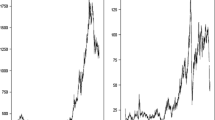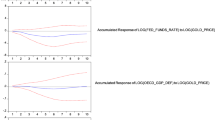Abstract
This study delivers further insights into oil and gold price dynamics and their relation to U.S. prices and the dollar exchange rate. Previous studies have frequently analyzed this issue regarding the price either of gold or of oil; however, the role of both quantities has not been analyzed simultaneously in a broader context. To tackle this caveat, we use monthly data for the nominal effective dollar exchange rate, oil, gold and U.S. prices from 1976:01 to 2011:11. We carefully analyze the long-run as well as the short-run dynamics and the long-run impact in terms of shocks, applying a cointegrated VAR model. The main conclusion we reach is that although gold and oil are both important commodities, their economic impact in terms of their shocks differs significantly. In the long-run, both quantities seem to be positively related and shocks to the gold price drive the system. In addition, the gold-oil spread is positively related to U.S. consumer prices, which implies a stronger relationship of consumer prices to the former.

Similar content being viewed by others
Notes
With respect to the general link between exchange rates and commodity prices, Chen at al. (2008) find robust power of commodity currencies in predicting global commodity prices, while their results provide little evidence of exchange rate predictability based on commodity prices.
Bialkowski et al. (2011) have recently analyzed the possibility of a speculative bubble in the gold price.
The latter shows the same movements such as the Europe Brent and the Dubai crude oil price series, which are also frequently used; however, observations prior to 1986 are not available for both.
Geometric rather than arithmetic averaging is applied owing to the fact that the latter may introduce an upward bias due to the measurement of changes in the dollar’s average exchange value (Loretan 2005).
The broad index provided by the Federal Reserve constitutes twenty-six currencies. Seven of them - the euro, the Canadian dollar, the Japanese yen, the British pound, the Swiss franc, the Australian dollar and the Swedish krona - are summarized under the major index. The nominal broad index increased by nearly 40 per cent between 1980 and 2004 owing to the higher inflation rate of several economies obtained in the broad index (Loretan 2005).
Previous research has illustrated that the relationship between consumer prices and the nominal exchange rate is nonlinear and mainly driven by nominal exchange rate adjustment. Since this pattern is not the main point of our study, we do not explain this finding in detail. A discussion is provided by Beckmann (2013).
The linkages between effective dollar exchange rates and the oil price have been examined by Beckmann and Czudaj (2013b).
References
Akram QF (2009) Commodity prices, interest rates and the dollar. Energy Econ 31(6):838–851
Amano R, van Norden S (1998) Oil prices and the rise and fall of the US real exchange rate. J Int Money Finance 17(2):299–316
Beckmann J (2013) Nonlinear adjustment, purchasing power parity and the role of nominal exchange rates and prices. N Am J Econ Finance 24(1):176–190
Beckmann J, Czudaj R (2013a) Gold as an inflation hedge in a time-varying coefficient framework. N Am J Econ Finance 24(1):208–222
Beckmann J, Czudaj R (2013b) Oil prices and effective dollar exchange rates. Int Rev Econ & Finance 27(1):621–636
Bénassy-Quéré A, Mignon V, Penot A (2007) China and the relationship between the oil price and the dollar. Energy Policy 35(11):5795–5805
Bialkowski JT, Bohl MT, Stephan PM, Wisniewski TP (2011) The gold price in times of crisis. Available from SSRN: http://ssrn.com/abstract=1718106
Blanchard OJ, Gali J (2007) The macroeconomic effects of oil shocks: why are the 2000s so different from the 1970s? NBER Working Paper Series, No. 13368
Blose LE (2010) Gold prices, cost of carry, and expected inflation. J Econ Bus 62(1):35–47
Capie F, Mills TC, Wood G (2005) Gold as a hedge against the dollar. J Int Financ Mark Inst Money 15(4):343–352
Cavallo M (2008) Oil prices and inflation. Federal Reserve Bank of San Francisco Economic Letter, 31, October 3
Chappell D, Dowd K (1997) A simple model of the gold standard. J Money, Credit, Bank 29(1):94–105
Chen S-S (2009) Oil price pass-through into inflation. Energy Economics 31(1):126–133
Chen S-S, Chen H-C (2007) Oil prices and real exchange rates. Energy Econ 29(3):390–404
Chen Y-C, Rogoff KS, Rossi B (2008) Can exchange rates forecast commodity prices? Q J Econ 125(3):1145–1194
Clostermann J, Schnatz B (2000) The determinants of the Euro-dollar exchange rate - synthetic fundamentals and a non-existing currency. Deutsche Bundesbank Working Paper, No. 02/00
Coudert V, Mignon V, Penot A (2008) Oil price and the dollar. Energy Studies Review 15(2):45–58
Czudaj R (2011) P-star in times of crisis - forecasting inflation for the Euro Area. Econ Syst 35(3):390–407
De Gregorio J, Landerretche O, Neilson C (2007) Another pass-through bites the dust? oil prices and inflation. Economía 7(2):155–208
Dickey D, Fuller WA (1979) Distribution of the estimates for autoregressive time series with a unit root. J Am Stat Assoc 74(366):427–431
Ewing BT, Malik F (2013) Volatility transmission between gold and oil futures under structural breaks. Int Rev Econ Finance 25:113–121
Golub S (1983) Oil prices and exchange rates. Econ J 93(371):576–593
Ghosh D, Levin EJ, Macmillan P, Wright RE (2004) Gold as an inflation hedge? Studies in Economics and Finance 22(1):1–25
Granger CWJ (1969) Investigating causal relations by econometric models and cross-spectral methods. Econometrica 37(3):424–438
Harmston S (1998) Gold as a store of value. World Gold Council, Research Study, No. 22
Herrera AM, Pesavento E (2009) Oil price shocks, systematic monetary policy, and the “great moderation”. Macroecon Dyn 13(1):107–137
Hooker MA (2002) Are oil shocks inflationary? asymmetric and nonlinear specifications versus changes in regime. J Money, Credit, Bank 34(2):540–561
Johansen S (1988) Statistical analysis of cointegration vectors. J Econ Dyn Control 12(2–3):231–254
Johansen S (1991) Estimation and hypothesis testing of cointegrated vectors in Gaussian vector autoregressive models. Econometrica 59(6):1551–1580
Johansen S (1994) The role of the constant and linear terms in cointegration analysis of nonstationary variables. Econ Rev 13(2):205–229
Johansen S (1996) Likelihood based inference on cointegration in the vector autoregressive model, 2nd edn. Oxford University Press, Oxford
Juselius K (2006) The cointegrated VAR model: econometric methodology and macroeconomic applications. Oxford University Press, Oxford
Juselius K, MacDonald R (2004) International parity relationships between the USA and Japan. Japan and the World Economy 16(1):17–34
Juselius K, Framroze Möller N, Tarp F (2011) The long-run impact of Foreign Aid in 36 African countries: insights from multivariate time series analysis. World Institute for Development Economic Research (UNU-WIDER), Working Paper, No. 2011/51
Kim MH, Dilts DA (2011) The relationship of the value of the dollar, and the prices of gold and oil: a tale of asset risk. Econ Bull 31(2):1151–1162
Kolluri BR (1981) Gold as a hedge against inflation: an empirical investigation. The Quarterly Review of Economics and Business 21(4):13–24
Krichene N (2005) A simultaneous equations model for world crude oil and natural gas markets. IMF Working Paper, No. 05/32
Krichene N (2006) World crude oil markets: monetary policy and the recent oil shock. IMF Working Paper, No. 06/62
Krugman P (1983) Oil and the dollar. NBER Working Paper, No. 554
Laurent RD (1994) Is There a role for gold in monetary policy? Federal Reserve Bank of Chicago, Economic Perspectives, March, 2–14
Le T-H, Chang Y (2011) Oil and gold: correlation or causation? DEPOCEN Working Paper Series, No. 22
Lee W-C, Lin H-N (2012) Threshold effects in the relationships between USD and gold futures by panel smooth transition approach. Appl Econ Lett 19(11):1065–1070
Levin ER, Wright RE (2006) Short-run and long-run determinants of the price of gold. World Gold Council, Research Study, No. 32
Lizardo RA, Mollick AV (2010) Oil price fluctuations and U.S. dollar exchange rates. Energy Econ 32(2):399–408
Loretan M (2005) Indexes of the foreign exchange value of the dollar. Fed Reserv Bull. 1–8
MacKinnon JG, Haug AA, Michelis L (1999) Numerical distribution functions of likelihood ratio tests for cointegration. J Appl Econ 14(5):563–577
Mahdavi S, Zhou S (1997) Gold and commodity prices as leading indicators of inflation: tests of long-run relationship and predictive performance. J Econ Bus 49(5):475–489
Malliaris AG, Malliaris M (2012) Are oil, gold and the euro inter-related? time series and neural network analysis. Rev Quant Finan Acc. forthcoming
Moore G (1990) Gold Prices and a Leading Index of Inflation. Challenge 33(4):52–56
Ng S, Perron P (2001) Lag length selection and the construction of unit root tests with good size and power. Econometrica 69(6):1519–1554
Pindyck R, Rotemberg J (1990) The excess Co-Movement of commodity prices. Econ J 100:1173–1189
Pukthuanthong K, Roll R (2011) Gold and the dollar (and the Euro, Pound, and Yen). J Bank Financ 35(8):2070–2083
Rahbek A, Hansen E, Dennis JG (2002) ARCH Innovations and their impact on cointegration rank testing, department of theoretical statistics. University of Copenhagen, Centre for Analytical Finance, Working Paper, No. 22
Sari R, Hammoudeh S, Soytas U (2010) Dynamics of oil price, precious metal prices, and exchange rate. Energy Econ 32(2):351–362
Sjaastad LA (2008) The price of gold and the exchange rates: once again. Resour Policy 33(1):118–124
Sjaastad LA, Scacciallani F (1996) The price of gold and the exchange rate. J Int Money Finance 15(6):879–897
Tuxen C (2009) Macroeconomic transmission mechanisms in a non-stationary world: Evidence from I(1) and I(2) cointegrated VAR models. PhD Thesis, No. 173, University of Copenhagen
Wang K-M, Lee Y-M, Nguyen Thi T-B (2011) Time and place where gold acts as an inflation hedge: an application of long-run and short-run threshold model. Econ Model 28(3):806–819
Worthington AC, Pahlavani M (2007) Gold Investment as an Inflationary hedge: cointegration evidence with allowance for endogenous structural breaks. Appl Financ Econ Lett 3(4):259–262
Zagaglia P, Marzo M (2012) Gold and the U.S. dollar: tales from the turmoil. Quant Finan. forthcoming
Zhang Y-J, Wei Y-M (2010) The crude oil market and the gold market: evidence for cointegration, causality and price discovery. Resour Policy 35(3):168–177
Author information
Authors and Affiliations
Corresponding author
Additional information
Thanks for valuable comments are due to the participants of the 14th INFER Annual Conference, University of Coimbra/Portugal.
Rights and permissions
About this article
Cite this article
Beckmann, J., Czudaj, R. Oil and gold price dynamics in a multivariate cointegration framework. Int Econ Econ Policy 10, 453–468 (2013). https://doi.org/10.1007/s10368-013-0237-8
Published:
Issue Date:
DOI: https://doi.org/10.1007/s10368-013-0237-8




